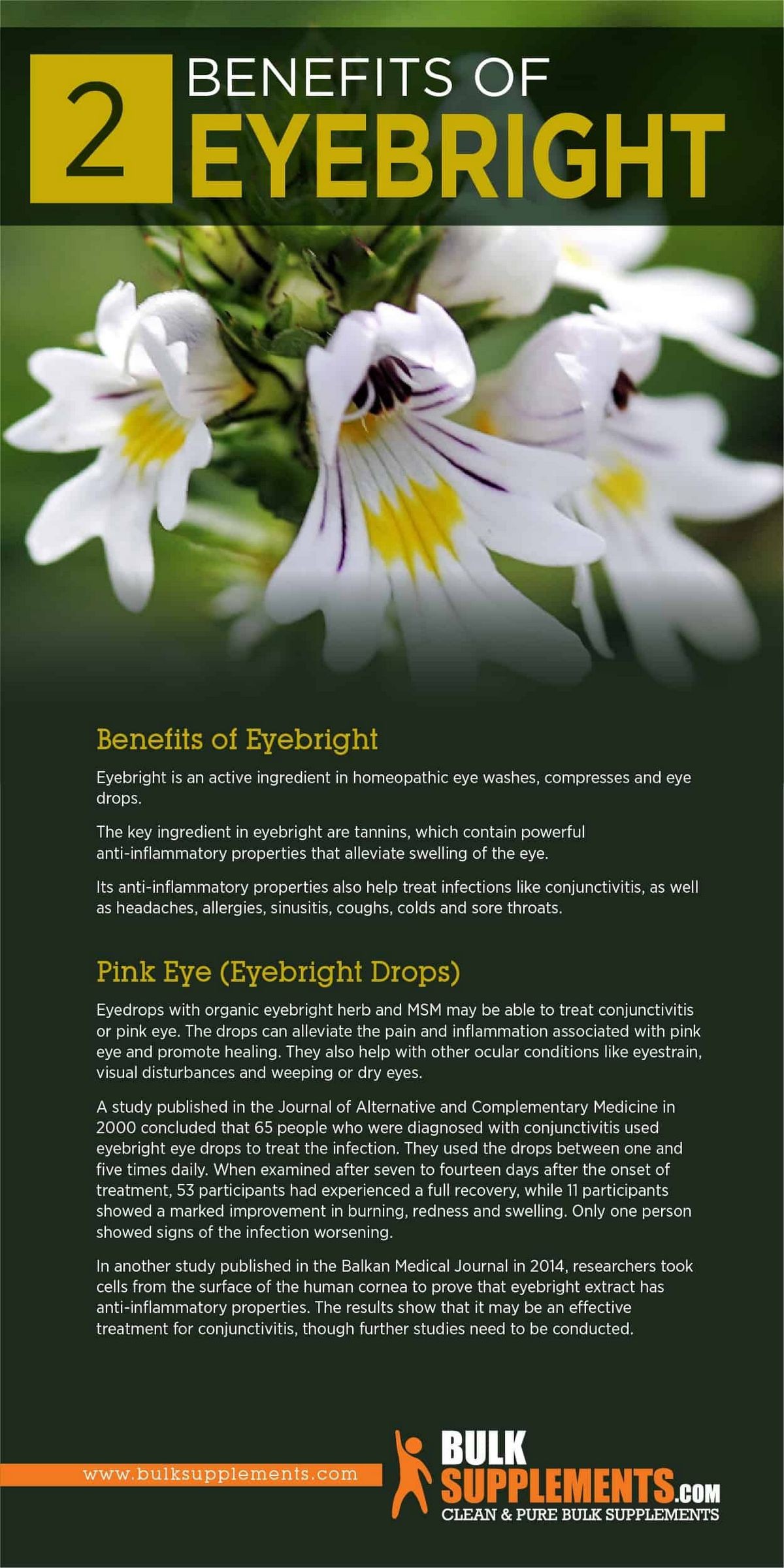
Contents
Eyebright: Benefits, Dosage, and Side Effects
Allergies are common health issues, and over-the-counter allergy medicines are readily available. However, some medications have side effects or may interact with other drugs.
People are always searching for natural products and botanical supplements to treat allergies and related conditions.
One such supplement is eyebright, a flower extract used to treat allergies, especially watery eyes and nasal discharge. However, there is limited data on its safety and effectiveness.
What is eyebright?
Eyebright (Euphrasia officinalis), also known as meadow eyebright and red eyebright, is native to Europe, particularly the United Kingdom. It thrives in open grasslands or meadows in temperate climates. While most eyebright comes from Europe, it is also found in Northern and Western Asia, as well as North America.
Eyebright is an annual plant.
- It grows two to eight inches tall and prefers good soil.
- It has deep-cut leaves and tiny, variegated blooms.
- The flowers can be purple or white, and the stem is slender and rigid.
- The leaves are about half an inch long and have four or five teeth on each side.
Eyebright is a hemiparasitic plant, deriving nutrients from other plants while also performing photosynthesis. Because it attaches to host plants, harvesting can be difficult. The best time to harvest is during the summer when it is in full bloom.
While eyebright thrives in open fields, it can also grow on rocky soil. However, in such conditions, the plant is usually less than an inch tall, and the stem does not branch extensively.
Extracts from eyebright’s leaves, stems, and flowers contain useful chemicals such as:
- Flavonoids like luteolin and quercetin
- Iridoglicozoids (aucubin)
- Tannins and phenolic acids, which have anti-inflammatory and mucus-reducing properties
For centuries, tea and dietary supplements made from eyebright have been used as herbal medicines.
The flavonoids in eyebright inhibit the release of histamine, a chemical substance that causes allergy symptoms like a runny nose and watery eyes.
8 health benefits of eyebright
- Reduces eye inflammation:
- Using cool eyebright tea as an eye compress may help with various eye irritations.
- To make eyebright tea, boil one teaspoon of properly cleansed eyebright herb in one and a half cups of water for 10 minutes.
- After draining the leaves, allow the liquid to cool, then use a cotton pad dipped in it as a compress three to four times a day.
- Treats conjunctivitis and cataracts:
- An eye drop made from eyebright was found to help 81.5 percent of people with conjunctivitis recover completely.
- An eyebright tincture wash can assist in treating cataracts.
- To relieve symptoms, mix five to eight drops of the tincture in two glasses of lukewarm water and wash the affected eyes every four to six hours.
- However, consult an herbalist before use and avoid prolonged use.
- Relieves cold, sinusitis, and seasonal allergies:
- Eyebright is considered a potential remedy for allergies and respiratory symptoms.
- The herb’s natural astringent and anti-inflammatory properties may help reduce mucus during colds and flu.
- Eyebright tea can be made by steeping an eyebright teabag in hot water for five minutes and drinking it two or three times a day.
- For dried eyebright leaves, add one teaspoon to a cup of hot water, let it soak for five to seven minutes, strain, and add honey if desired.
- Treats other upper respiratory tract conditions:
- Eyebright can help with conditions such as the common cold, hay fever, sore throats, and hoarseness.
- It can also reduce irritations caused by measles in the bronchial and pulmonary regions.
- Reduces acne and skin irritation:
- The antibacterial and astringent properties of eyebright can aid in the healing of acne and irritated skin.
- Applying cool eyebright tea, poultice, or tincture to the affected area can help treat acne outbreaks.
- To make a poultice, crush fresh eyebright leaves and flower petals, apply to the acne, and leave for 20 minutes before rinsing.
- Another option is to dab a cotton ball in cold steeped tea or a combination of eyebright tincture and cold water, then gently apply to the affected areas.
- Alternatively, mix eyebright oil with face moisturizer and apply it to the skin overnight.
- Promotes skin wound healing:
- Eyebright is used as an astringent to aid in the healing of skin wounds.
- A cool eyebright poultice can help tighten the skin and promote wound healing.
- Protects the liver:
- The presence of aucubin in eyebright may help reverse liver damage and treat jaundice.
- Eyebright promotes good liver function by cleansing and detoxifying the blood.
- Aucubin has hepatoprotective properties and is effective against the hepatitis B virus.
- Improves memory:
- Eyebright is rich in beta-carotene.
- A study found that men (65 years and older) who took beta-carotene supplements for 18 years showed improvements in verbal memory tests compared to the placebo group.
- To improve memory, mix dried eyebright powder, fennel seeds, honey, and minced mace, then consume a small amount daily with water or fruit juice.
- Alternatively, drinking eyebright tea daily can help prevent memory loss and preserve cognitive function.
Dosage of eyebright extracts
The dosage of eyebright extracts depends on the type of extract. Here are the recommended dosages:
- Dried herb: Take two to four grams by infusion three times a day.
- Tincture:
- Prepared in a 1:1 ratio with a 25 percent alcohol solution. Take 2 to 4 mL three times a day.
- Prepared in a 1:5 ratio with a 45 percent alcohol solution. Take 2 to 6 mL three times a day.
The appropriate dosage depends on the severity of the condition. For eye-related issues, a poultice can be used alongside tea therapy.
Some people believe that using an eyebright herbal supplement can help maintain or improve vision. However, it is important to consult a doctor before using eyebright for any purpose.
Are there any possible side effects of eyebright?
Most people do not experience serious side effects from oral consumption of eyebright. However, using it directly on the eyes is not recommended due to the risk of contamination or eye infection.
The most common side effects associated with eyebright tincture include:
- Nausea
- Confusion
- Tearing and itching of the eyes
- Headache
- Difficulty breathing
- Redness of the eyes
- Sneezing
- Vision issues
- Toothache
- Sweating
- Constipation
- Coughing
- Insomnia
Contraindications of eyebright
- Pregnancy and breastfeeding: Avoid using eyebright during these periods due to insufficient evidence regarding its safety.
- Eyebright may lower blood sugar levels in some individuals. Use with caution and monitor blood sugar if you have diabetes.
- Eyebright may interfere with blood sugar regulation during and after surgical procedures. Discontinue use at least 15 days before scheduled surgery.


